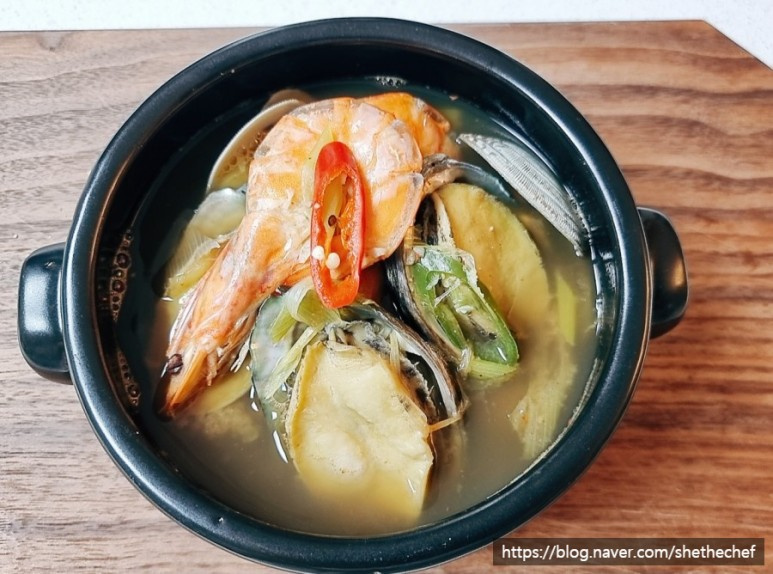Seafood Stew (Haemul Ttukbaegi): A Taste of Jeju Island
Make Jeju-Style Seafood Stew at Home: Refreshing, Savory, and Flavorful

This Haemul Ttukbaegi (Korean Seafood Hot Pot) brings back memories of my trips to Jeju Island. The broth is incredibly refreshing and delicious, packed with the savory umami from fresh clams, abalone, and shrimp. It’s a light yet deeply flavorful soup that’s perfect for a hearty meal or as a restorative dish after a long day.
Main Ingredients- 8 abalones
- 8 whole shrimp
- 1 handful of clams (purged of sand)
- 1/3 zucchini
- 3 shiitake mushrooms
- 10 cm green onion
- 1 green chili pepper
- 1/2 red chili pepper
- 1 Tbsp minced garlic
- 3 Tbsp soybean paste (Doenjang)
- 3 Tbsp Tsuyu (Japanese soy sauce seasoned with dashi)
- Small piece of dried kelp (for broth)
- Small amount of dried anchovies (dish)
- Small amount of dried shrimp (ttaksaeu) (for broth)
- Small bunch of crown daisy (for garnish)
Cooking Instructions
Step 1
Prepare all the ingredients for your seafood stew. Scrub the abalones clean with a brush. You can peel the shrimp or leave the shells on for extra flavor. Soak the clams in saltwater to purge any sand. Slice the zucchini and mushrooms into bite-sized pieces. Chop the green onion and chili peppers diagonally.

Step 2
Let’s make a rich and refreshing broth, the heart of this dish! In a pot, combine the dried kelp, dried anchovies, and dried shrimp. Add enough water to cover the ingredients. (Alternatively, you can use a pre-made broth pack for convenience.)

Step 3
As the broth begins to simmer, skim off any impurities or foam that rise to the surface. This step ensures a clear and clean-tasting broth.

Step 4
Once the broth is ready, strain out the solids to get a clean broth. (Be sure to remove the kelp early on, as prolonged boiling can make the broth bitter.)

Step 5
While the broth is simmering, you can prepare the vegetables and seafood. This will save you time when it’s time to assemble the stew. Lightly score the abalone with a knife; this helps it absorb flavors and become more tender when cooked.

Step 6
Dissolve 3 tablespoons of soybean paste (Doenjang) into the prepared broth. Make sure to mix well so there are no clumps.

Step 7
Once the broth with the soybean paste is boiling, add the purged clams first. As the clams open, they will release their natural briny flavor into the stew.

Step 8
When the clams are partially cooked, add the whole shrimp and abalone to the pot. These fresh seafood additions will make your stew wonderfully rich.

Step 9
Season the stew with 3 tablespoons of Tsuyu for added umami and depth. If Tsuyu is unavailable, you can adjust the seasoning with regular soy sauce or salt to your preference.

Step 10
Once the shrimp turn pink and are cooked through, add all the prepared vegetables – zucchini, mushrooms, green onions, and chili peppers. Let it simmer for a short while. The natural sweetness and aroma from the vegetables will further enhance the broth.

Step 11
Finally, stir in 1 tablespoon of minced garlic for a fresh kick. Garnish with crown daisy, simmer briefly, and then turn off the heat immediately. Avoid overcooking after adding garlic, as its fresh aroma might dissipate.

Step 12
Ladle the hot, bubbling seafood stew into individual earthenware pots (ttukbaegi). Your homemade Jeju-style Haemul Ttukbaegi is ready to be enjoyed!




